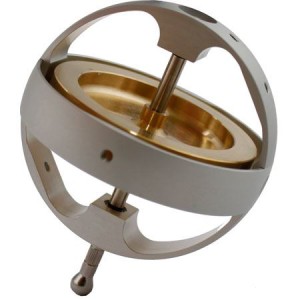Not everyone knows what a gyroscope is, but most everyone has seen them at one time or another and most have had the opportunity to use them, even if they did not realize it. One of the most common gyroscopes is a spinning wheel that is inside of three rings that are called gimbals. These little devices are fun to watch and have been used in a variety of things throughout history, since their invention back in 1743 when it was called either the “Serson’s Speculum” (after John Serson) or the “Whirling Speculum”.
The History of Gyroscopes
 It was introduced in 1743 and used to locate the horizon when someone was out in a misty or foggy weather situation. Later, in 1817, Johann Bohnenberger invented a device that more closely resembles today’s gyroscopes. He called it the “Machine” and it was based on a rotating sphere. In 1832, it became a disk thanks to Walter R. Johnson and it became a teaching device. By 1852, Leon Foucault used it as a part of an experiment that showed the rotation of Earth and in 1860 electric motors made it possible for the gyroscope to spin indefinitely.
It was introduced in 1743 and used to locate the horizon when someone was out in a misty or foggy weather situation. Later, in 1817, Johann Bohnenberger invented a device that more closely resembles today’s gyroscopes. He called it the “Machine” and it was based on a rotating sphere. In 1832, it became a disk thanks to Walter R. Johnson and it became a teaching device. By 1852, Leon Foucault used it as a part of an experiment that showed the rotation of Earth and in 1860 electric motors made it possible for the gyroscope to spin indefinitely.
After those remakes, a toy company, Chandler Company of Indianapolis, began making a simple toy that worked with a pull string and pedestal. After that, the fascination and use of these devices continued to grow. As time went on, they became even more useful as well.
The Science behind Gyroscopes
When it comes to how a gyroscope works, you have to understand how it is designed. You have a center wheel that spins on a rotor. The three gimbals that surround it spin around to keep the center wheel spinning without it having to rely on anything but momentum and gravity. The thing is, with this simple, but very complicated design, you can tilt the device and flip it upside down, and everything will continue to function the way it should. In short, no matter what the wheel and gimbal must deal with, gravity takes over to ensure that it still works the way it should. This makes it ideal for helping things that we use today to maintain the right orientation. It is a concept that some people use everyday thanks to the invention of a self balancing electric scooter.
How We Use Them Now
In today’s world, gyroscopes are used in everything from radio controlled helicopters to the Hubble Space telescope. They are used in things that cannot rely on magnetic compasses to keep them going in the right direction. The theory behind them is also used in bicycles, motorcycles, ships, and most other types of vehicles in one way or the other. Back in the day when everyone had a mouse with a tiny little ball in the middle of them, they were making use of a gyroscope. As technology continues to improve, the gyroscope is right there with us in a smart balance wheel and our smart phones with automatically rotating screens, as well as anything else we use that needs to be able to self-orient.
It kind of makes you wonder how we have so much technology and still base the things we use on a device that was invented over 273 years ago. This machine was invented long before our technology knew what to do with it. It has been reinvented and renamed many times, but in the end it is still the basis of what we use today. Perhaps we should all say, “Thank you” to John Seson for what he has given us today.